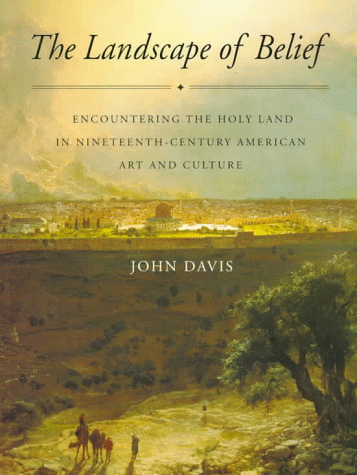
The Landscape of Belief: Encountering the Holy Land in Nineteenth-Century American Art and Culture. By John Davis. Princeton: Princeton University Press, 1996. pp. 264 + 107 illus.
Americans have maintained an ongoing relationship with the Holy Land. From pilgrimages to Palestine, to models and artwork that recreated holy sites on American soil, to repeated descriptions of the United States as a new Zion, Americans have expressed a profound cultural attachment to the Biblical homeland. The Holy Land is one of the most richly imagined places in American culture and its representation has always been a central component in the construction of American identity. In The Landscape of Belief, John Davis offers a unique perspective on artistic portrayals of the Holy Land in nineteenth-century America. In his richly narrated and illustrated volume, Davis explores the ways that Americans formulated their own national identities through depictions of the Holy Land.
Davis divides the book into two parts. The first four chapters explore the range of Holy Land images that became popular in the nineteenth century. Davis carefully outlines the diverse sources of interest in Palestine as well as the cultural and technological innovations that spurred Holy Land representation. He begins by presenting an overview of the ways that the Holy Land served as a metaphor for Americans as they shaped their own culture. References to the Land of Israel abounded in the religious rhetoric of the early nation and in the political debates over slavery and the Civil War. After summarizing the prevalent usages of the Holy Land in American discourse, Davis focuses on the growth of the travel industry after the Civil War, examining the travel literature, religious pilgrimages, and archaeological findings that grounded American relationships to the Holy Land. As an increasing number of American artists, scholars, and writers traveled to Palestine, they began producing visual and literary works that built a vernacular culture surrounding the Holy Land.
In one of the most engaging portions of the book, Davis describes the many visual media that shaped the images of the Holy Land in American public culture. At “Palestine Park,” the landscape recreation of the Holy Land created by New York’s Chautauqua Society, visitors were able to experience the sacred geography of Israel by walking through large-scale [End Page 343] models and participating in Bible lectures and reading circles. In the years before the popularization of photography, many Americans owned stereoscopes and purchased sets of stereographs that enabled them to view the landscape and sites of Palestine and to travel vicariously to the Holy Land. Through these and other examples, Davis argues convincingly that “a certain ‘Holy Land’ consciousness permeated most levels of nineteenth-century American society” (p. 51).
Davis is particularly interested in the panoramic paintings and photographs that formed the basis of American conceptions of the Holy Land. Landscape paintings were the dominant motif of representing the Holy Land before the Civil War, but the medium of photography quickly eclipsed the canvass as the most popular form of portraying Palestine and its people. The strength of Davis’s discussion lies in his ability to connect the many different visual representations of the Holy Land, revealing the pervasiveness of these images in American culture. In his narrative, Davis contextualizes artistic productions within the framework of American social, political, and religious interests in the Holy Land, demonstrating the cultural matrix of American preoccupation with Palestine and the efforts to render it accessible to the American public.
In the second half of The Landscape of Belief, Davis focuses on four individual painters: Miner Kellogg, Edward Troye, James Fairman, and Frederic Church. Each of these artists devoted at least part of his career to painting Palestine. Readers will be most familiar with Frederic Church, by far the most well-known of the four painters. For Davis, the issue is not the popularity of the artists, but their particular relevance as case studies for understanding the relationship between their works and the popular interest in the Holy Land described in the first part of the book. Davis presents a compelling and intricate analysis of the artists and their paintings, but his argument might have been strengthened...
Discover right here a list of things one ought to recognise while journeying with the aid of bus in israel. דילים לחול ברגע האחרון
ReplyDelete